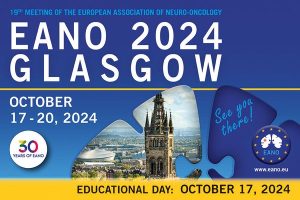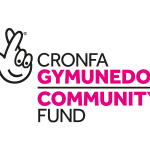
EANO is the European conference that brings together everyone with a brain tumour related focus. It encourages exchange and collaboration between all relevant disciplines and brings together scientific and clinical research to bridge gaps on our understanding and management of brain tumours. People from across the globe (don’t be misled by European) present the latest outcomes in clinical trials and key advances in basic and translational science. This year’s conference, held in Glasgow, included talks on advanced and novel therapies, novel targets, artificial intelligence and data sharing, quality of life and patient voice in research. We’re invited to speak every year and make sure we focus on bringing the patient closer to research and research closer to patients. Presentations we have given have included the role of shared decision making, how to have a voice as a caregiver, using data to change outcomes, coaching as a transformative force to name a few. This year we talked about the role of patient and caregivers in research.
These are thoughts and themes that we have brought back with us from Glasgow.
Low grade glioma (LGG) and adolescent and young adults (AYA)
LLG are common in AYA and disrupt key life stages such as building careers, relationships and families. The burden these tumours bring is signiciant and impacts on all stages of life.
What did we learn?
Cognitive symptoms caused by LGG and ensuing treatment significantly impact on employment, family and autonomy. Uncertainty about life expectancy complicates decision making about life events and many people feel misunderstood by their peers.
What does this mean?
We need improved communication, improved information provision and support for people living with LGG, which includes their families. For those diagnosed as children, the challenge shifts to navigating long term physical, cognitive and psychosocial effects. Survivors face reduced chances of pregnancy and childbirth, which negatively impacts on quality of life.
How can brainstrust help?
We run webinars on fertility and coach people who want to build resilience and learn acceptance. We will make sure that our online information about low grade glioma and the challenges living with one brings is broad in scope and deep in evidence, so it is authoritative and trustworthy, fulfilling the PIF Tick criteria. We will continue to build the community of AYA and others who are living with this diagnosis.
Neuropsychiatry
We know from research that neuropsychiatric symptoms vary depending on location, size, type of tumour as well as treatments. Common symptoms include neurocognitive impairment, mood disorders, personality changes and psychotic symptoms. These can change over time, depending on medication, tumour progression and treatment response.
What did we learn?
All kinds of things. The initial diagnosis is reported as being the most distressing experience. Domestic violence and aggression is probably underreported as caregivers don’t feel able to speak up. Fear of recurrence is one of the greatest unmet needs of both patients and caregivers and forms part of the distress. Patients experience living with a brain tumour as a double threat to both their survival and identity. Some patients find psychological based therapies and interventions offered at diagnosis as too soon.
What does this mean?
Understanding the impact of the clinical pathway and the symptoms is key if we are to support people more effectively. Early detection and appropriate treatment will enable people to lead a better quality of life. Information and signposting is important and timing is everything. Multidisciplinary care is needed to manage the complex landscape of neuropsychiatry.
How can brainstrust help?
We can continue to support with behaviour and personality change through wider promotion of our resource and coaching workshops. We will produce a Know How on identifying neuropsychiatric changes. And we will also revisit the clinical pathway to see what interventions might help at key touchpoints. Capturing common neuropsychiatric symptoms will be useful for us to deliver more effective coaching.
Liquid biopsy
A liquid biopsy is a non-invasive laboratory test that analyses a patient’s blood, urine, or other bodily fluid to detect cancer cells or tumour DNA. It can help doctors:
- Find cancer early
- Plan treatment
- Monitor how well treatment is working
- Determine if cancer has returned
- Understand genetic changes in a tumour
- Choose the best treatment for a patient
And it can mean that surgery isn’t needed.
What did we learn?
This was a hot topic. Glioblastoma (GBM) is traditionally diagnosed and characterized using neuroimaging and brain biopsies. These methods, however, suffer from limited specificity and sensitivity. There are also surgical risks associated with tumour sampling and this prevents monitoring molecular progression of a GBM which can change over time. Consequently, the identification of circulating GBM biomarkers is crucial for non-invasive tracking of the disease from diagnosis to relapse.
What does this mean?
It is very early days in this research but increasingly this is looking like it could be a possibility. If it works this would be a reliable, non-invasive method for the diagnosis and follow-up of people living with a GBM; it will be of real value to patients who are unable to have a surgical biopsy, for whatever reason. It has the potential to help too with prognosis and also the longer monitoring of GBM, supporting the implementation of liquid biopsy in GBM care.
How can brainstrust help?
We will watch how this unfolds and report back. We can also gather real world data and capture experiences of liquid biopsy.
Caregivers
Caregivers are key in the support and care of people living with a brain tumour and yet it is often hard for a caregiver to have a voice.
What did we learn?
Caregivers might have a higher need for 1to1 and group support rather than informational resources. They struggle with exhaustion and a pressure to be positive. They lack confidence in the care they are giving and the top 5 needs identified are:
- Dealing with treatment
- Caring for themselves
- Understanding physical symptoms and side effects
- Understanding mental and behavioural changes
- Practical matters.
Emotional concerns were marked as the highest concern, with practical and informational concerns as secondary. These included uncertainty sadness, worry, overwhelm, anxiety
What does this mean?
Themes were summarised into 5 categories:
- Caregiver needs
- Provision of emotional and practical care
- Coping with uncertainty
- Coping with illness progression
- Supporting end of life care
How can brainstrust help?
We’re well placed to support with living with uncertainty and end of life care, with our key resources and coaching workshops. But there are other things we can do. There is scope for us to offer coaching to couples where there is a shared objective. We can also support with helping caregivers to have a voice in what is a complex landscape. We have our Know How about this and we can develop online meet ups for caregivers where experience and problems can be shared.
Public and patient involvement
EANO 2024 in Glasgow provided a comprehensive overview of the latest research, clinical trial updates, and emerging therapies for brain tumours. The conference brought together a diverse group of neuro-oncology specialists, researchers, and patient advocates, all eager to share knowledge and discuss the challenges and successes in the field. Sessions were varied, with experts presenting the newest data on innovative treatment approaches, especially in targeted and personalised therapies.
What did we learn?
A strong focus was placed on the value of multidisciplinary collaboration and patient-centric approaches, particularly through PPIE (Patient and Public Involvement and Engagement) initiatives, which were highlighted as essential for aligning research with real patient needs and expectations.
One of the key themes was the current landscape of clinical trials for brain tumours, which has expanded significantly with advancements in immunotherapy, gene therapy, and adaptive trial designs. Researchers discussed the encouraging but complex results of using checkpoint inhibitors and cell therapies. Emerging data from gene therapy trials also sparked discussion, particularly with trials focusing on customising treatments based on genetic mutations specific to gliomas and other aggressive brain tumours.
Speakers emphasised the importance of integrating adaptive technologies into trial designs, not only to enhance patient recruitment and retention but also to allow for more precise monitoring and data collection.
What does this mean?
That the role of PPIE is going to grow to meet ever more complex needs so we need a community of both skilled and PPIE naive people to deliver this.
How can brainstrust help?
We need to stay ahead of the game so that we can keep everyone updated about the latest research and how essential it is to keep patients closer to research and research closer to patients.
Want to receive all the latest research straight to your inbox?
Sign-up our curated, jargon-free weekly research newsletter. Click here to fill out our contact form and select ‘research’ to opt into our research newsletter.
Get involved with research…
If you would like to use your experience and insight to support clinical research, consider signing up to be a PRIME advocate for brainstrust.
If you or someone you love is living with a brain tumour and have any questions around this latest news, or want to access support, give us a call on 01983 292 405 or email hello@brainstrust.org.uk. You can also visit our little brainstrust website which features support for children affected by brain tumour.





